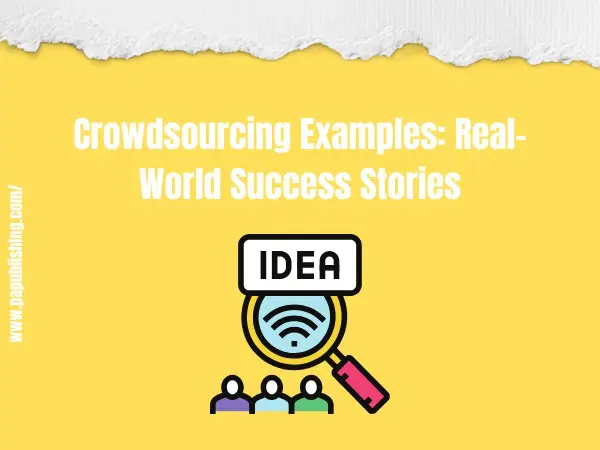Crowdsourcing Examples and Innovative Ideas for Success
Today’s fast-paced, innovation-driven world has taken over the digital market, overcoming obstacles and aiding the marketing community. Businesses and organizations are constantly struggling to find new ways to solve problems, generate ideas, and stay ahead of the competition. Crowdsourcing is one of the most effective strategies for achieving this. The real-life crowdsourcing examples abound across all industries, narrating its success.
Continue reading to learn more about real-world crowdsourcing examples that highlight its potential and share actionable ideas for using this tool.
What is Crowdsourcing?
The term ‘crowdsourcing’ is a combination of the words ‘crowd’ and ‘source.’ It was coined by Jeff Howe in 2006. It is defined as the art of bringing larger groups of people from the community, for efficient problem-solving and effective communication.
From startups to multinational corporations, crowdsourcing has become a go-to strategy for solving challenges and driving creativity. This helps businesses understand their audience better and launch products and services successfully. Moreover, these interactive campaigns can yield some great content created by the followers. Businesses can use this in their marketing strategies.
Crowdsourcing Examples: Real-World Success Stories
The crowdsourcing approach isn’t a one-size-fits-all solution. One needs to understand the application diversity and its impact on branding for its better outcome.
Here are some crowdsourcing examples to earn your faith in this business strategy.
Wikipedia
Wikipedia is perhaps the most well-known example of crowdsourcing. This free encyclopedia, which has a storm of information, depends on millions of writers worldwide to write and edit its content. Gathering information with the help of people all around, Wikipedia has become one of the most extensive sources of information.
Unlike some crowdsourcing projects that offer compensation, Wikipedia has an entirely unpaid model. Such crowdsourcing examples show how it isn’t just about financial rewards. It also plays a role in the digital market, maximizing business value.
Netflix Prize
Netflix Prize, launched by Netflix in 2006 was a program where participants tried to create an algorithm to predict how users would pick their movie recommendations. This service ran until September 2009. A reward prize of $1 million was announced for the team that could improve Netflix’s movie recommendation system by at least 10%.
This idea of a crowdsourcing hub attracted many data scientists and engineers from all across the world. It led to active discussions on Netflix’s online forum. Surprisingly, some top teams included experts and common people like us with no prior experience. They learned from scratch and added to the program’s growth, proving the success of such crowdsourcing examples.
Unsplash
Unsplash is one of the most remarkable crowdsourcing examples, started by Mikael Cho with just $19 in half a day. What began as a simple idea soon became the top traffic source for his struggling project. Eventually, it became a successful company built on crowdsourcing.
Unsplash grew rapidly because it solved major problems for many, providing easy access to free, high-quality photos. Instead of hiring photographers, it encouraged people to share their work on the forum via crowdsourcing. In return, they received exposure and acknowledgment. This approach built a vast community, which now generates over 13 billion photo impressions monthly.
PepsiCo
An iconic example of crowdsourcing is the “Do Us a Flavor” campaign launched by PepsiCo’s Frito-Lay division in 2012. This contest encourages consumers worldwide to submit new chip flavor ideas, and millions have submitted their ideas over the years.
This campaign is promoted through social media, allowing active community involvement via public voting for their favorite flavors. Some of the winning flavors from previous years include: Cheesy Garlic Bread (2012), Kettle-Cooked Wasabi Ginger (2014), Southern Biscuits and Gravy (2015), and Crispy Taco (2017).
Lego Ideas
Lego Ideas, launched by LEGO, is yet another successful crowdsourcing project. It allows fans to submit their creative LEGO designs. Through public voting, winning designs are reviewed for production.
This allows the brand to connect with its customers, accept their innovative design ideas, and implement the best sets in their launches.
My Starbucks Idea
Starbucks takes a unique approach to crowdsourcing by actively involving its customers in shaping the brand. Inspired by the success of the 2014 ‘White Cup Contest,’ Starbucks introduced a creative campaign, “My Starbucks Idea.” This campaign offered a platform for customers to share their suggestions on how to improve their favorite coffee place. They could also vote on product ideas.
They received over 150,000 suggestions, out of which 277 made it to the shelves. This built a better brand narrative and added to its customer satisfaction.
Waze Navigation App
The Waze app is a perfect example of crowdsourced information helping people in their daily lives. This community-based GPS app helps people receive live updates on the traffic situation. It provides information on jammed roads, alternate route options, accidents, and road hazards. This has helped improve the commuting experience for millions worldwide.
Crowdsourcing-Oriented Ideas for Your Business
Now that you’ve seen some real-life success stories, let’s discuss some crowdsourcing ideas to implement in your organization.
Product Development
Involve your customers in the product development process. Take into consideration their opinion on features, designs, or improvements. Involve them in product trials and provide offerings and input.
This will ensure that customer needs are met and also create a sense of ownership and loyalty between customers and the company.
Crowd Creation
Crowd creation, a mix of content creation and crowdsourcing, helps brands create content with much more diversity. Companies may use this strategy to bring together groups of interested people who will create high-quality content. This helps create content for your social media, blog, and marketing campaign, all in a cost-effective manner.
Problem-Solving
If your company is facing any problems, consider crowdsourcing solutions through different platforms. This approach offers many expert opinions and successful ways of getting back on track. In return, companies may offer rewards as compensation.
Crowdfunding
While not traditional crowdsourcing, crowdfunding is a favorable way of sourcing finances for your startup. Platforms like Kickstart and Indiegog allow you to raise funds and validate ideas by engaging a community of supporters. In return, companies may even offer shares in their project.
Best Practices to Maximize Crowdsourcing Productivity
Crowdsourcing has great potential, but it’s not a quick fix. To make it work, businesses need to approach it carefully. Here are some best practices applied in the above-mentioned crowdsourcing examples as well for their success:
Well-Defined Goals
Clearly define your goals as what you aim to achieve through this strategy. Are you looking for idea generation, funding, or marketing? This will help you design an effective campaign.
Identify Your Target Audience
Understanding your target audience is the key to the success of your campaign. Knowing who you want to reach with your crowdsourcing efforts can help you narrow down the best available platforms.
Offer Incentives
People around the globe are more likely to be actively involved in your crowdsourcing campaign if you offer incentives. They could be in the form of monetary compensation, prizes, or other perks.
Ensure Effective Communication
Keep your audience informed with updates and take into regard their feedback, maintaining a two-way communication road. This will convey mass opinions and also help incorporate them for better outcomes.
Analyze the Results
After each project’s completion, analyze the results and list down success and failure factors. It is an essential element of marketing strategy, improving results.
Conclusion
As the world becomes increasingly interconnected, the need for crowdsourcing has held its ground and grown over time. With the help of the community’s collective intelligence, you can pave the way for new opportunities, reduce project costs, generate creative ideas, and stay ahead of the competition.
By learning from these crowdsourcing examples, businesses can make the most of this approach and stay competitive in today’s market.






